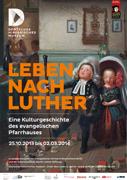Life after Luther
A Cultural History of the Evangelical Parsonage
25 October 2013 to 2 March 2014
Concept: Bodo-Michael Baumunk, Dr. Shirley Brückner
Project coordination: Prof. Dr. Rosmarie Beier-de Haan
A wellspring of universal education and bourgeois life, a model for Christian conduct, an origin of literature, philosophy and science – as a way of life the Evangelical parsonage has for centuries served as a projection surface for social and familial ideals. The exhibition “Life after Luther. A cultural history of the Evangelical parsonage” follows the development of this society-shaping institution from the Reformation on up to the present day.
Portraits from five centuries, objects of everyday use, personal souvenirs and a variety of clerical vestments, including robes of the very first women pastors, illustrate the transformations in Protestant parsonages over the years. Precious illustrated books from the 17th and 18th centuries give an impression of the educational horizon of a typical parsonage library. Photos, sound and film documents on the “Kirchenkampf”, the struggle of the churches during the Nazi period, as well as on the repression, adaptation and church opposition in the GDR shed light on the way the Protestant churches reacted to totalitarian challenges in the 20th century. The important role of the parsonage in the “Peaceful Revolution” of 1989/90 and the political engagement of West German churches in the peace movement of the 1980s will also be examined.
Supplementing the exhibition, an extensive monitor installation on the ground floor of the exhibition hall takes reference to the present and the future of the tradition-steeped institution of the Evangelical parsonage. It poses questions about the field of activities in the present-day occupation of pastor and on the precarious situation of the parishes, the changes in living forms in the parsonage itself and the current character of the pastor’s family as a model for society. In addition, the installation focuses on persons in the public spotlight who share the background of having come from a pastoral family. Are the children of a parsonage something special? The parsonage – a springboard into politics?







